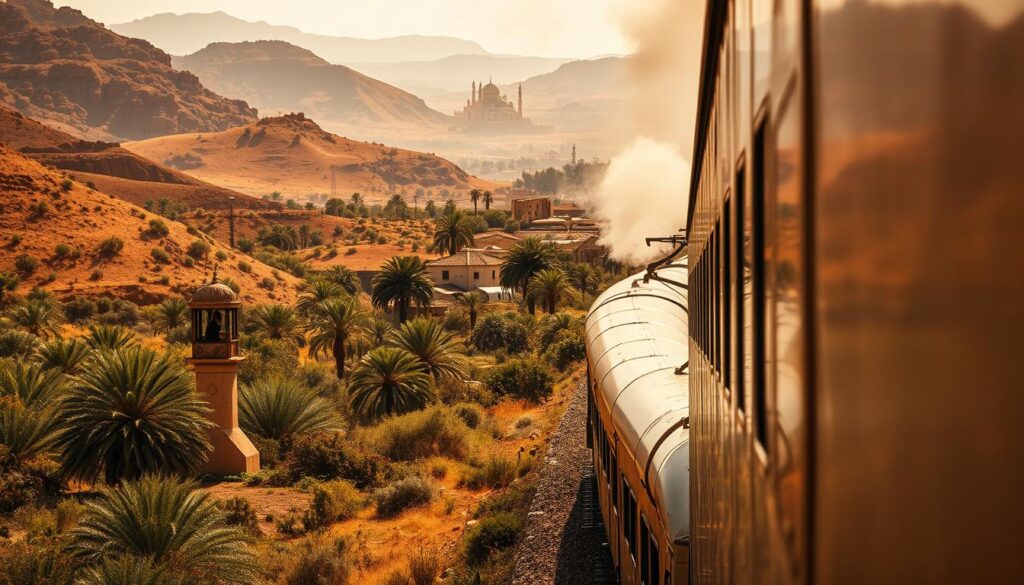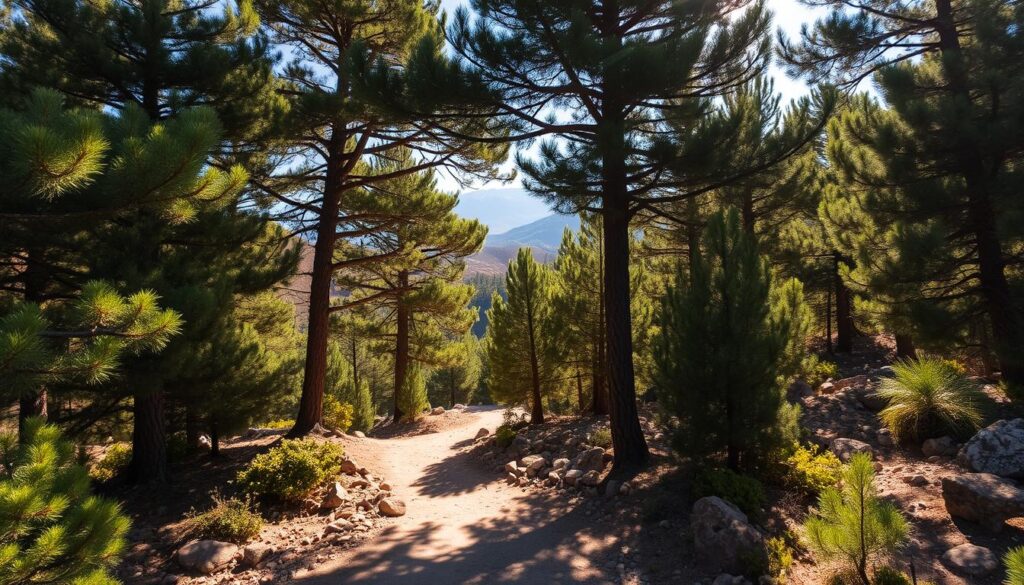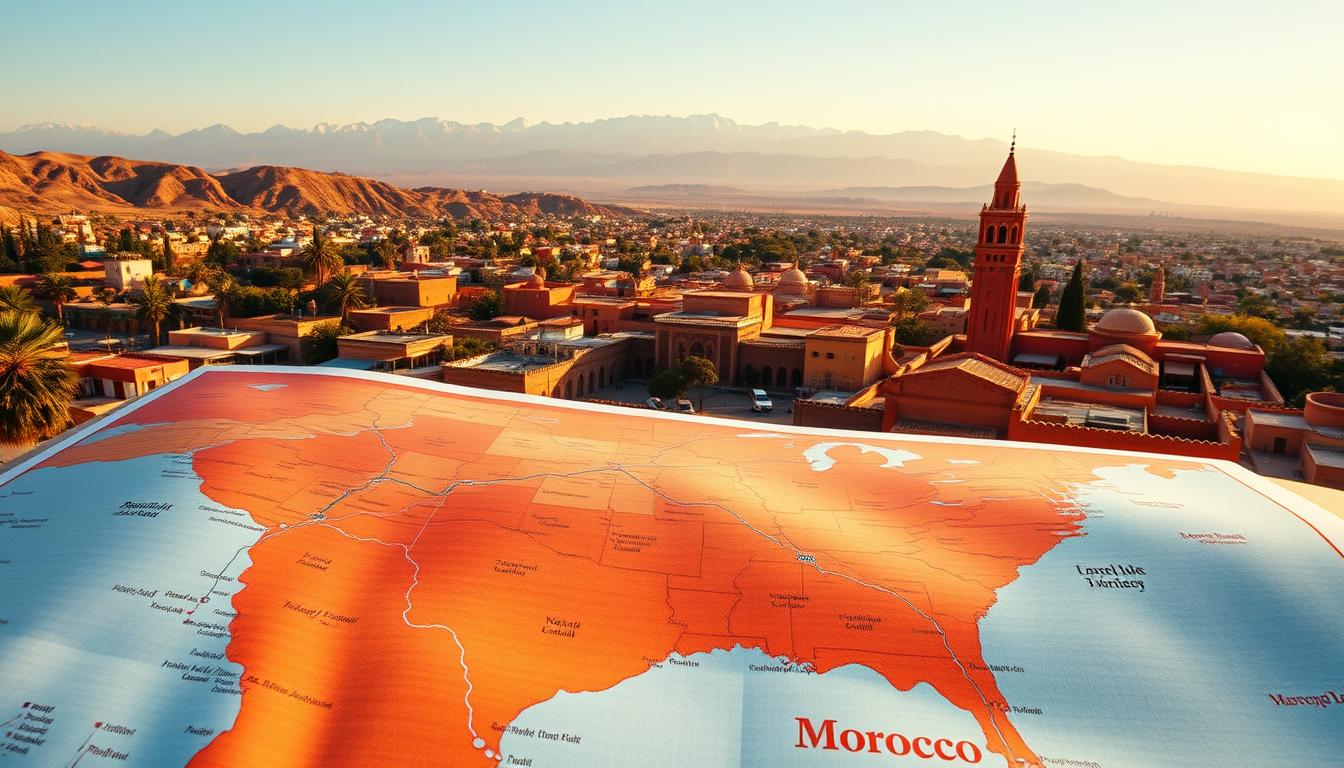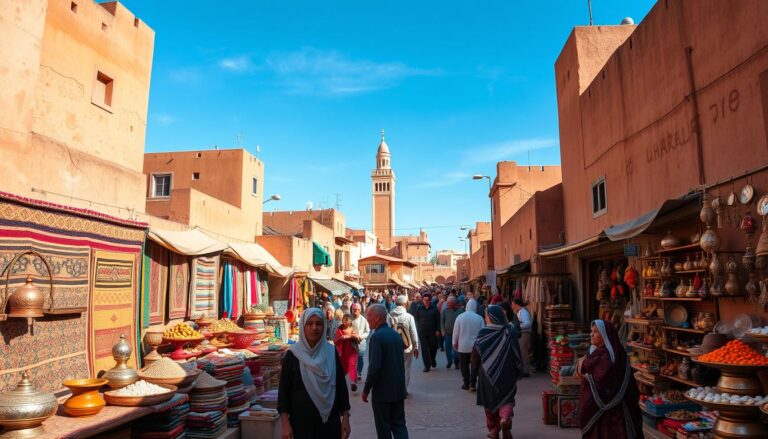How to Spend a Week in Morocco: The Ultimate Itinerary
Embarking on a Morocco travel itinerary is an exciting adventure, filled with vibrant cultures, stunning landscapes, and rich history. Planning your Morocco vacation planning carefully is key to experiencing the best of what this fascinating country has to offer.
A well-structured 7-day journey can take you through bustling cities, serene deserts, and picturesque coastal towns. From the vibrant souks of Marrakech to the tranquil beauty of the Sahara Desert, every moment is an opportunity to immerse yourself in the unique charm of Morocco.
With this ultimate itinerary, you’ll be able to explore the highlights of Morocco, creating unforgettable memories along the way.
Key Takeaways
- Discover the vibrant culture of Marrakech
- Explore the historical significance of ancient cities
- Experience the serene beauty of the Sahara Desert
- Enjoy the picturesque landscapes of coastal towns
- Immerse yourself in the rich history of Morocco
Discovering the Magic of Morocco
The allure of Morocco lies in its vibrant cities, serene landscapes, and rich cultural heritage. Morocco is a country that seamlessly blends traditional and modern elements, creating a unique travel experience. From the bustling streets of Marrakech to the tranquil beauty of the Sahara Desert, Morocco has something to offer every kind of traveler.
What Makes Morocco a Unique Destination
Morocco’s rich cultural tapestry is woven from its Arab, Berber, and French influences, making it a fascinating destination for cultural enthusiasts. The country’s vibrant cities are known for their historic landmarks, bustling markets, and delicious cuisine. Visitors can explore the ancient medinas, visit historic sites like the Hassan II Mosque in Casablanca, or relax in the serene beauty of the Atlas Mountains.
A Morocco tour guide can enhance your experience by providing insights into the local culture, history, and hidden gems that might otherwise remain undiscovered. With their expertise, travelers can navigate the complexities of Moroccan culture and fully immerse themselves in the local way of life.
| Aspect | Description | Highlights |
|---|---|---|
| Culture | Blend of Arab, Berber, and French influences | Rich heritage, vibrant festivals |
| Landscape | Diverse geography from mountains to deserts | Atlas Mountains, Sahara Desert |
| Cities | Vibrant urban centers with historic landmarks | Marrakech, Fes, Casablanca |
Best Time to Visit for a One-Week Trip
Planning a trip to Morocco requires considering the best time to visit, especially for a one-week itinerary. The ideal time to visit Morocco is during the spring (March to May) and autumn (September to November), when the weather is mild and pleasant. These periods are perfect for exploring the cities, mountains, and deserts without the harsh conditions of the peak summer or cold winter.
“The best time to visit Morocco is in the spring or autumn when the weather is mild, making it ideal for exploring the diverse landscapes and vibrant cities.”
For a one-week trip, it’s advisable to focus on one or two main regions to avoid excessive travel time and make the most of your visit. For instance, combining Marrakech with the Sahara Desert or Fes with the Middle Atlas offers a balanced experience of culture, history, and natural beauty.
Planning Your 7-Day Moroccan Adventure
A well-planned itinerary is crucial for a memorable Moroccan adventure. With so much to see and experience, from the bustling streets of Marrakech to the serene Sahara Desert, preparation is key to making the most of your trip.
Getting to Morocco: Flights and Entry Requirements
To start planning, you’ll first need to book your flights to Morocco. Major airlines operate into Marrakech Menara Airport (RAK) and Casablanca Mohammed V Airport (CMN). Ensure your passport is valid for at least six months beyond your planned departure date, and check if you need a visa to enter Morocco.
Transportation Options Within the Country
Morocco offers various transportation options, including trains, buses, and taxis. The train network is efficient for long-distance travel between major cities like Marrakech, Fes, and Casablanca. For shorter distances or more rural areas, consider using grands taxis or renting a car for flexibility.
Accommodation Types: Riads, Hotels, and Desert Camps
Morocco is renowned for its diverse accommodation options. In cities like Marrakech and Fes, you can stay in traditional riads, which offer a unique cultural experience. For a luxurious stay, consider high-end hotels. If you’re venturing into the Sahara, desert camps provide an unforgettable experience under the stars.
Packing Essentials for Morocco
When packing for Morocco, consider the season and your itinerary. Essentials include comfortable clothing, sun protection, and layers for cooler evenings. For desert adventures, don’t forget sturdy shoes and a scarf to protect against the sand.
Day 1: Arriving in Casablanca
As you touch down in Casablanca, the vibrant heart of Morocco, your 7-day adventure is just beginning. This bustling city is a perfect blend of modernity and tradition, offering a unique start to your Morocco 7-day trip.
Morning: Hassan II Mosque and Corniche
Begin your day with a visit to the magnificent Hassan II Mosque, one of the largest mosques in the world. Its intricate architecture and stunning location overlooking the Atlantic Ocean make it a must-visit. Afterwards, take a leisurely stroll along the Corniche, a scenic waterfront area perfect for a morning walk.
Afternoon: Exploring the Old Medina
In the afternoon, immerse yourself in the historic Old Medina, a labyrinth of narrow streets filled with local markets and traditional crafts. As you explore, you’ll encounter a mix of cultures and traditions that define Casablanca’s unique character. Be sure to try some local street food and engage with the friendly locals.
Evening: Dining at Rick’s Café
For dinner, head to Rick’s Café, a legendary establishment made famous by the movie “Casablanca.” Enjoy traditional Moroccan cuisine in an atmosphere that echoes the glamour of old Hollywood. As you dine, you’ll feel as though you’re part of a classic movie scene, making for a memorable Casablanca travel experience.
“The world is a book, and those who do not travel read only one page.” This quote by Saint Augustine resonates deeply as you savor the flavors of Morocco in this iconic setting.
Day 2: Journey to Fes
The second day of your Moroccan adventure unfolds with a scenic train ride from Casablanca to Fes, a city steeped in history and tradition. As you travel, the Moroccan landscape unfolds outside your window, a mix of urban sprawl and rural beauty.
Morning: Train from Casablanca to Fes
Boarding the train in Casablanca, you’ll enjoy a comfortable ride to Fes. Morocco’s train network is efficient, with frequent departures throughout the day. The journey offers a great opportunity to relax or catch up on work while the countryside rolls by.

Afternoon: First Impressions of Fes
Upon arrival in Fes, you’ll be struck by the city’s ancient architecture and vibrant atmosphere. The old medina, a labyrinth of narrow streets and alleys, awaits your exploration. Take your time to wander, absorbing the sights and sounds.
Evening: Dinner and Relaxation in a Traditional Riad
In the evening, retire to a traditional riad, where you can enjoy a delicious Moroccan dinner. Riads offer a unique blend of traditional charm and modern comfort, making them the perfect place to relax after a day of travel.
| Activity | Location | Time |
|---|---|---|
| Train Ride | Casablanca to Fes | Morning |
| Explore Medina | Fes | Afternoon |
| Dinner | Traditional Riad | Evening |
Day 3: Immersing in Fes
Day 3 in Fes is all about delving into the city’s historic medina and uncovering its hidden gems. Fes, one of the oldest imperial cities in Morocco, is a treasure trove of history, culture, and traditional craftsmanship.
Morning: Exploring the Ancient Medina with a Guide
Begin your day with a guided tour of the Fes medina, a UNESCO World Heritage site. The narrow alleys and bustling souks are filled with the scent of spices, leather, and fresh bread. Your guide will navigate you through the labyrinthine streets, pointing out significant landmarks and sharing stories about the city’s rich history.
Afternoon: Visiting the Tanneries and Artisan Workshops
In the afternoon, visit the famous Chouara Tannery, one of the oldest tanneries in Morocco. Witness the traditional tanning process, a craft that has been passed down through generations. You can also explore nearby artisan workshops where local craftsmen work on pottery, weaving, and metalwork.
Evening: Moroccan Cooking Class Experience
End your day with a Moroccan cooking class where you’ll learn to prepare traditional dishes like tagine and couscous. This hands-on experience not only teaches you about Moroccan cuisine but also allows you to enjoy the fruits of your labor with a delightful dinner.
Some key highlights of your Day 3 in Fes include:
- Exploring the historic medina with a knowledgeable guide
- Visiting the ancient tanneries and witnessing traditional craftsmanship
- Learning the art of Moroccan cooking and savoring local flavors
As you immerse yourself in the culture and traditions of Fes, you’ll gain a deeper appreciation for this enchanting city and its people.
Day 4: Crossing the Middle Atlas to Merzouga
On Day 4, travelers embark on a picturesque journey across the Middle Atlas, bound for the Sahara’s edge at Merzouga. This day is filled with diverse landscapes, from lush cedar forests to the arid beauty of the desert’s periphery.
Morning: Scenic Drive Through Cedar Forests
The morning begins with a scenic drive through the cedar forests of the Middle Atlas, an area known for its natural beauty and biodiversity. The cool, shaded roads wind through the trees, offering a serene start to the day. As one travels deeper into the forest, the scent of cedar fills the air, and the sound of birds provides a soothing background melody.

Midday: Stops in Ifrane and Midelt
As the journey continues, stops are made in the towns of Ifrane and Midelt. Ifrane, often referred to as “Little Switzerland” due to its European-style architecture and picturesque surroundings, offers a unique cultural experience. Midelt, situated at a high altitude, provides breathtaking views of the surrounding landscape. These stops not only break the journey but also offer insights into the local culture and way of life.
“The Middle Atlas region is a treasure trove of natural beauty, with its forests, mountains, and valleys offering a glimpse into Morocco’s diverse landscapes.” – A travel enthusiast
Evening: Arriving at the Edge of the Sahara
As the day draws to a close, travelers arrive at Merzouga, on the edge of the Sahara Desert. The Sahara desert experience begins here, with the vast expanse of the Erg Chebbi dunes visible in the distance. The evening is spent relaxing and preparing for the adventures that lie ahead in this desert landscape.
| Location | Highlights |
|---|---|
| Cedar Forests | Scenic drives, biodiversity, serene atmosphere |
| Ifrane | European-style architecture, cultural experience |
| Midelt | Breathtaking views, high altitude |
| Merzouga | Sahara desert experience, Erg Chebbi dunes |
Day 5: Sahara Desert Experience
Day 5 in Morocco is all about immersing yourself in the majestic beauty of the Sahara Desert. The adventure begins early, with a day filled with exploration and excitement.
Morning: Exploring Merzouga Village
Start your day by exploring the charming village of Merzouga. Take a leisurely walk around the village, interact with the locals, and get a glimpse into their traditional way of life. You can also visit a local Berber family and learn about their customs and traditions. As one traveler noted,
“The hospitality of the Berber people is something that will stay with me forever.”
Afternoon: Camel Trek into the Erg Chebbi Dunes
In the afternoon, embark on a camel trek into the Erg Chebbi dunes, a truly unforgettable experience. As you ride your camel through the vast expanse of golden sand, you’ll feel as though you’re in a dream world. The trek offers breathtaking views of the surrounding landscape and a chance to witness the serene beauty of the desert.
Evening: Night Under the Stars in a Desert Camp
As the sun sets, you’ll arrive at a desert camp, where you’ll spend the night under the stars. Enjoy a delicious traditional Moroccan dinner, and then relax around a campfire, listening to local music and stories. The night sky is filled with stars, offering a magical and peaceful atmosphere. As the saying goes, “The stars are the diamonds of the night.”
Day 6: From Desert to Mountains – Heading to Marrakech
The morning after a magical night in the desert, you’ll set off on the next leg of your journey, bound for Marrakech. This day is filled with diverse landscapes, from the serene desert sunrise to the rugged beauty of the Atlas Mountains.
Morning: Sunrise in the Desert and Return Journey
Begin the day by witnessing the sunrise over the Erg Chebbi dunes, a truly unforgettable experience. As the sky lightens, the sand dunes transform into a kaleidoscope of colors. After a leisurely breakfast, you’ll start your journey back, leaving the tranquility of the desert behind.
Midday: Journey Through the Dades Valley and Ouarzazate
As you travel towards Marrakech, you’ll pass through the Dades Valley, known for its stunning scenery and lush oases. A stop in Ouarzazate, often referred to as the “Gateway to the Sahara,” offers a glimpse into the region’s rich history and cinema heritage.
Evening: Crossing the High Atlas Mountains and Arrival in Marrakech
The final leg of your journey involves crossing the High Atlas Mountains, where the landscape shifts dramatically. As you descend into the vibrant city of Marrakech, the bustling streets and markets signal the end of your rural journey. You’ll arrive in the evening, ready to explore the city’s many charms.
How to Spend a Week in Morocco: The Ultimate Itinerary for Day 7 in Marrakech
On Day 7, Marrakech unfolds its treasures, from bustling squares to serene gardens. As we dive into the heart of this vibrant city, the rich tapestry of Moroccan culture, history, and hospitality comes alive.
Morning: Exploring Jemaa el-Fnaa and the Souks
Begin your day in the iconic Jemaa el-Fnaa, a UNESCO World Heritage site. This bustling square is a sensory overload in the best possible way, with snake charmers, street performers, and food stalls. As the day progresses, explore the surrounding souks (markets), where you can find everything from traditional crafts to modern souvenirs.
Afternoon: Visiting Bahia Palace and Majorelle Gardens
After a morning of exploration, visit the Bahia Palace, a masterpiece of Islamic craftsmanship. The palace’s intricate tile work, carved wood, and serene courtyards offer a glimpse into the lives of the Sultan’s courtiers. Later, head to the Majorelle Gardens, a botanical haven created by French artist Jacques Majorelle and later restored by Yves Saint Laurent. The vibrant blue architecture and exotic plants make for a tranquil retreat.
Evening: Final Moroccan Dinner Experience
Conclude your Moroccan adventure with a traditional dinner at a local riad. Savor tagines, couscous, and other local delicacies, accompanied by the warm hospitality of Moroccan hosts. It’s a fitting end to a week filled with discovery and cultural immersion.
As we conclude this 7-day itinerary, Marrakech leaves a lasting impression, a blend of the traditional and the contemporary, the bustling and the serene. It’s a city that stays with you, inviting you to return and explore further.
Practical Tips for Your Moroccan Journey
As you prepare for your Moroccan adventure, it’s essential to be equipped with practical tips to navigate this vibrant country. Morocco is a land of diverse cultures, landscapes, and experiences, and being prepared will enhance your journey.
Money Matters
Understanding the local currency, the Moroccan dirham, and having a budget in place can help you manage your expenses effectively. It’s also worth noting that bargaining is a common practice in traditional markets and souks. Be prepared to negotiate prices, and don’t be afraid to walk away if you’re not comfortable with the price.
| Expense | Average Cost (MAD) | Average Cost (USD) |
|---|---|---|
| Meal at a local restaurant | 30-50 | 3-5 |
| Accommodation in a riad | 500-1000 | 50-100 |
| Camel ride in the Sahara | 200-300 | 20-30 |
Cultural Etiquette
Morocco is a conservative country, and respecting local customs is crucial. Dress modestly, especially when visiting mosques or rural areas. Learn a few basic Arabic phrases, such as “hello” (as-salamu alaykum) and “thank you” (shukraan), to show respect for the culture.
Safety Tips
As with any travel, being aware of your surroundings is key. Keep an eye on your belongings, especially in crowded areas, and avoid traveling alone at night. Stay informed about local conditions and follow the advice of your tour guides or local authorities.
Must-Try Dishes
Moroccan cuisine is a delicious blend of flavors and spices. Be sure to try local specialties like tagine, couscous, and pastilla. Respect local dining etiquette by eating with your right hand and waiting for the host to start the meal.
Conclusion: Making the Most of Your Week in Morocco
A well-planned Morocco 7-day trip can be a life-changing experience, offering a mix of vibrant culture, rich history, and breathtaking landscapes. By following this ultimate itinerary, travelers can explore the country’s diverse attractions, from the bustling streets of Marrakech to the serene Sahara Desert.
Effective Morocco vacation planning involves understanding the country’s unique cultural nuances, respecting local customs, and being prepared for the adventures that lie ahead. With this guide, visitors can navigate the complexities of traveling in Morocco, ensuring a smooth and enjoyable journey.
As you reflect on your week-long adventure in Morocco, the memories of camel treks under the starry sky, the warmth of traditional riads, and the vibrant colors of bustling souks will linger. Morocco’s diverse landscapes and cultures promise an unforgettable experience, making it a destination that stays with you long after you leave.
FAQ
What is the best time to visit Morocco for a one-week trip?
The best time to visit Morocco is during spring (March to May) and autumn (September to November), when the weather is mild and pleasant, making it ideal for exploring the country’s diverse landscapes and cities.
What are the must-try Moroccan dishes?
Some must-try Moroccan dishes include tagine, couscous, harira, and pastilla, which showcase the country’s rich culinary heritage and blend of Arab, Mediterranean, and African flavors.
How do I get to Morocco?
The primary international airport in Morocco is Mohammed V International Airport in Casablanca, which receives flights from major airlines worldwide. You can also enter Morocco by land or sea from neighboring countries or Europe.
What are the accommodation options in Morocco?
Morocco offers a range of accommodation options, including riads, hotels, desert camps, and guesthouses, catering to different budgets and preferences, from luxurious to budget-friendly.
Is Morocco safe for American travelers?
Morocco is generally considered safe for American travelers, but it’s essential to take normal precautions, be aware of local customs, and stay informed about local conditions to ensure a smooth and enjoyable trip.
What are the essential items to pack for Morocco?
When packing for Morocco, consider including comfortable clothing, sunscreen, a hat, sunglasses, and a scarf, as well as respectful attire for visiting mosques or rural areas.
Can I use credit cards and ATMs in Morocco?
Major credit cards and ATMs are widely accepted in Morocco’s cities and tourist areas, but it’s still a good idea to have some local currency, dirhams, for smaller purchases and when traveling to rural areas.
What is the currency in Morocco?
The official currency of Morocco is the Moroccan dirham (MAD).
How do I bargain in Moroccan markets?
Bargaining is a common practice in Moroccan markets, so be prepared to negotiate prices, start with a lower offer, and be respectful, as vendors appreciate friendly and courteous interactions.
When planning to spend a week in Morocco, ensure to pack comfortable clothing, sunscreen, a hat, sunglasses, and a scarf. Don’t forget respectful attire for mosque visits or rural areas. Credit cards and ATMs are widely accepted in cities and tourist spots, but having some local currency, Moroccan dirhams, is advisable for small purchases and rural travel. In Moroccan markets, bargaining is customary, so negotiate prices respectfully, start with a lower offer, and engage in friendly interactions with vendors.


